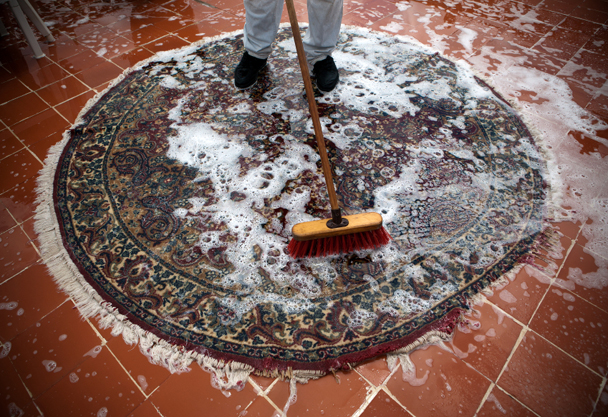 The most effective technique to keep a rug clean is to prevent it from getting dirty in the first place. If your lifestyle allows it, taking off your outdoor shoes while entering the house (like most rug-weaving countries do) is an excellent idea. Bare-foot or sock-foot traffic is far softer on a rug than a hard outdoor-shoe sole (or spike heel), and leaving your outside shoes at the front door tracks in significantly less dirt.
The most effective technique to keep a rug clean is to prevent it from getting dirty in the first place. If your lifestyle allows it, taking off your outdoor shoes while entering the house (like most rug-weaving countries do) is an excellent idea. Bare-foot or sock-foot traffic is far softer on a rug than a hard outdoor-shoe sole (or spike heel), and leaving your outside shoes at the front door tracks in significantly less dirt.
Only have your rug cleaned when it is truly necessary. In some cases, this will imply a yearly cleaning of rugs. Rugs in other locations can last for years without needing expert cleaning.
Try one of the following methods to determine how unclean a rug is:
Pick up a corner of the rug and kick the back of it sharply while holding it. If a cloud of dirt flies from the pile, the rug is unclean and should be cleaned. PLEASE NOTE: Some dust and wool fibers are natural!
Kneel on the rug and vigorously rub the pile in a short arc with your hand for 5 to 10 seconds. Examine your fingers and palm: if your hand is dirty, the rug should be cleaned.
Fold a section of the rug back on itself with the pile facing up so that the pile opens along a line of knots. Look down into the base of the pile at the rug’s foundation. If the warp and weft appear dirty, this indicates that there is dirt deep in the pile that a home vacuum cleaner cannot reach. The rug should be cleaned.
Should you clean your oriental rugs yourself?
Small rugs are simple to clean on your own. On a good, sunny day, the process is best done in a utility room or garage (on a clean floor) or outside on a clear driveway or paved walk:
Vacuum both sides thoroughly.
Cool water and moderate liquid soap or rug shampoo (no strong detergents, ammonia water, or sudsy ammonia water) should be used to shampoo the rug. First, test for color run in a small area. Use a soft, long-haired brush or a firm, non-shedding sponge to remove the hair. Brush the pile firmly in the direction of the nap, but do not scrub too vigorously. Soapy water should be used to completely wet the nap.
Use the same soap solution to clean the fringes. Brush frequently away from the pile with a laundry brush.
Thoroughly rinse with running water.
Squeeze extra water out with a rubber window squeegee. Repeatedly squeegee the pile in the direction of the nap until no more water is squeezed out.
Allow to dry flat. Turn the rug over when the nap feels dry; the back is likely still damp. DRY COMPLETELY.
Brush or lightly vacuum the pile if it feels stiff after drying.
First Aid for Rugs….
Always try to work on the spill without expanding the area of the spill.
Spilled food/Pet urine
Urine is the most dangerous of the most common spills. It can produce significant color run in the carpeting, and the stench can be difficult to remove or mask. Pee can also chemically alter the structure of a rug by hardening and stiffening the foundation, and the presence of urine in a rug can attract moths. Repeated wettings can cause the rug’s foundation to lose mechanical strength, causing the rug to fracture and shatter when rolled or folded.
When there is a food accident or urine on a rug, the situation is much easier to address if the location is treated quickly, before the spill dries. Using paper towels or a clean, white cloth, blot up as much liquid as possible. Rinse off as much of the spill as you can.
If you don’t have the time or patience to clean your oriental rugs yourself, we are here to help. Call 864-430-1499 TODAY to schedule an appointment!
Recent Comments